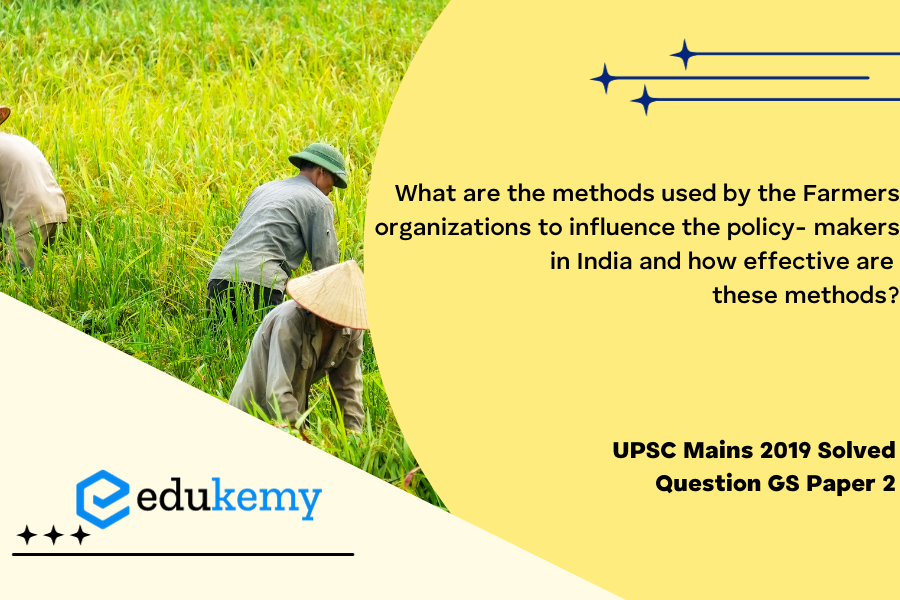Farmers’ organizations in India employ various methods to influence policy-makers and advocate for their interests. One prevalent approach involves leveraging the collective strength of its members through protests, demonstrations, and rallies. Mass mobilization serves as a powerful tool, drawing attention to pressing agricultural issues and compelling policymakers to address the concerns of the farming community. Additionally, farmers’ organizations engage in constructive dialogue with policymakers, participating in consultations, meetings, and committees to ensure their perspectives are considered in the policy formulation process. These interactions contribute to a more nuanced understanding of the challenges faced by farmers and provide a platform for the exchange of ideas.
Tag: Pressure groups and formal/informal associations and their role in the Polity.
Contents
Decoding the Question:
- In the Introduction, briefly write about the Farmers’ organizations.
- In Body,
- First, discuss methods used by the organizations to influence the policymakers and their effectiveness.
- In Conclusion, try to write about the importance of Farmers’ organizations and suggest a way forward.
Answer:
Farmers organizations refer to a group of farmers who are organized to protect their interests related to issues like minimum support price, subsidies, welfare schemes for farmers, etc. For example, Bharathiya kisan Sabha, shetkari sangatan, Karnataka raitha Sangha etc are some farmer organizations. Such organizations are perceived to have the ability to generate resources, mobilize support, and exert pressure with the help of their members. They operate at different levels from the local to the national.
Method Used by the Organizations:
Awareness generation: They try to gain public support and sympathy for their goals and their activities by carrying out information campaigns, organizing meetings, filing petitions, etc. Most of these groups try to influence the media to give more attention to these issues.
Lobbying: Powerful farmers groups like sugarcane farmers of Maharashtra and UP try to influence policymaking in their favor like getting favorable MSP and payment of arrears.
Protest: They often organize protest activities like strikes or disrupting general administration. These protests of late have centered around issues like loan waiver, higher MSP, free electricity, etc. The recent farmers’ march to Delhi under the Bharatiya Kisan Sangh banner was such an example.
Activism: This method includes publicizing important issues, petitioning courts, preparing draft legislation, and gaining public attention in matters related to farmers like issues about GM crops.
Fast unto death protests: Farmers normally resort to these protests when their moderate protests don’t satisfy their demands. For example protests by Tamil Nadu farmers in the national capital last year.
Other methods: Sometimes they resort to other types of protests like throwing their crops on the road in case of low prices, blocking railways, etc.
Recent trends: Farmers organizations recently have also employed innovative ways like spilling milk and vegetables on highways or appearing to consume dead rats, soil, and urine at Delhi’s Jantar Mantar, etc.

Limitations of the Farmer’s Organisations:
- These organizations have a Lack of or inadequate professional management of the business and financial assistance.
- Due to the protest of these organizations, the government often takes populist measures such as farm loan waivers, higher MSP, cash transfers in farmers’ accounts, etc., instead of employing a solution to the real problem, which is not beneficial for farmers in the long run.
- The lack of effective implementation of policies and inadequate infrastructure hinder the interest of farmers.
The positive outcome of these efforts:
- Farmers’ associations have been able to get concessional benefits like loan waivers and higher MSPs in the past. For example, the governments of Madhya Pradesh, Chhattisgarh, and Rajasthan waived loans immediately after coming to power.
- Pressure from farmers’ organizations has led the government to take the initiative for farmer welfare like PM KISAN.
- It has led to awareness in general about the plight of farmers and has helped them to garner wide support for them in society.
- These methods have helped expose the poor state of farmers in India and have led to reforms like better credit facilities, Jan Dhan Yojana, etc.
The Farmer’s organizations play a crucial role in shaping government policies by effectively representing issues. The agricultural reforms are necessary to ensure that India has a productive, sustainable, and remunerative agriculture sector. The government should engage all stakeholders while making policies for sustainable agriculture.
In case you still have your doubts, contact us on 9811333901.
For UPSC Prelims Resources, Click here
For Daily Updates and Study Material:
Join our Telegram Channel – Edukemy for IAS
- 1. Learn through Videos – here
- 2. Be Exam Ready by Practicing Daily MCQs – here
- 3. Daily Newsletter – Get all your Current Affairs Covered – here
- 4. Mains Answer Writing Practice – here


